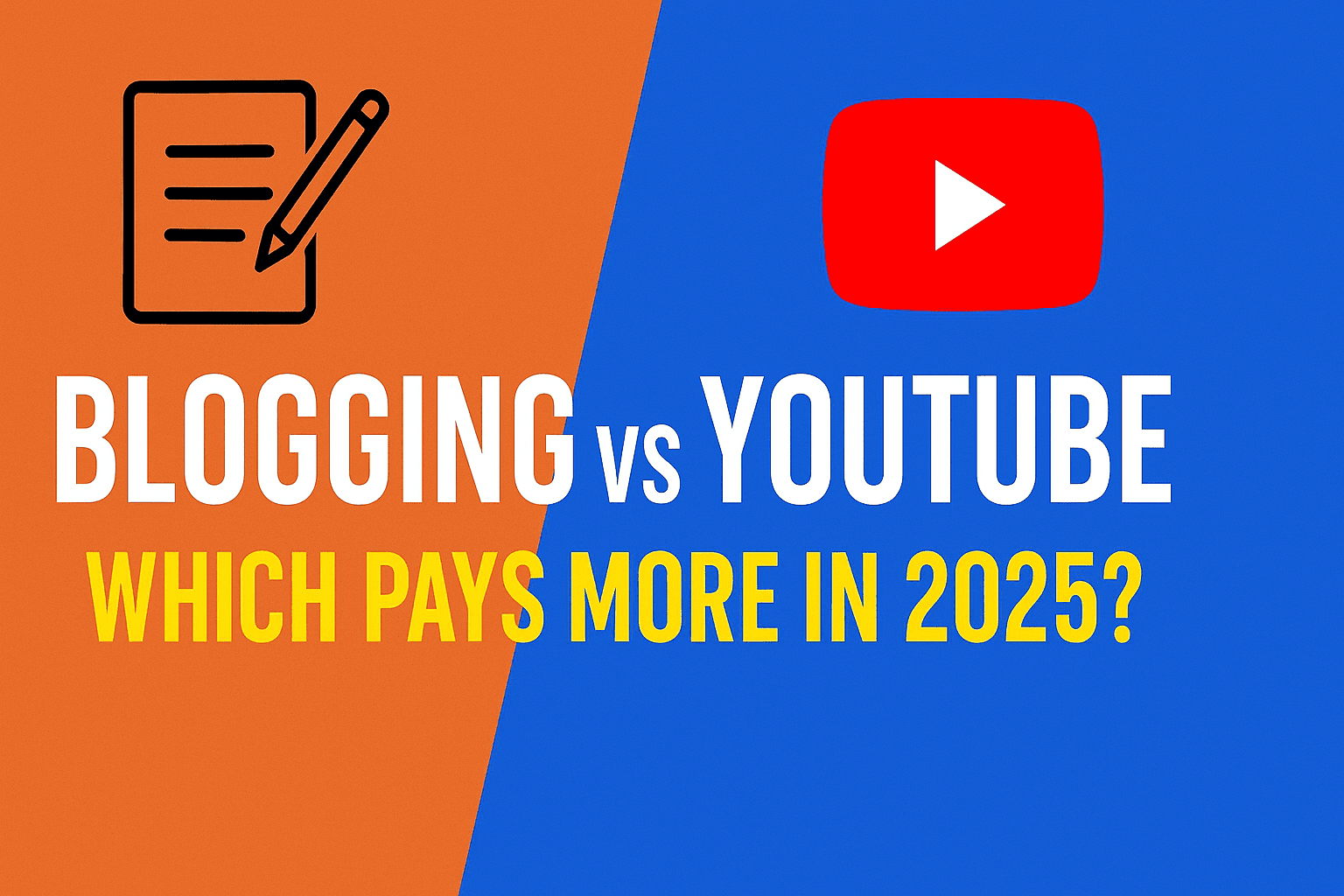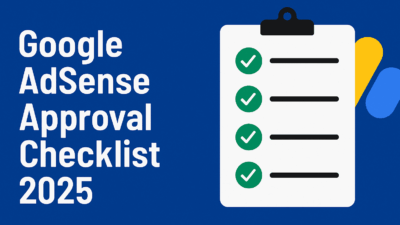Blogging vs YouTube: Which pays more in 2025? This debate continues as creators navigate a digital world full of monetization opportunities. Both blogging and YouTube have matured, diversified, and professionalized. But which one is more profitable today?
The answer depends on several variables: your niche, traffic source, monetization methods, and your content strategy. In this detailed comparison, we’ll explore real-world earning models, startup costs, algorithm dynamics, and income scalability to help you decide which platform better suits your goals in 2025.
Monetization Options: A Head-to-Head Comparison
💰 Blogging Income Streams
- Display Ads (Google AdSense, Mediavine, Ezoic)
- Affiliate Marketing
- Sponsored Posts
- Digital Products (ebooks, courses, templates)
- Email Marketing / Subscriptions
Most bloggers combine multiple streams. A single blog post can generate passive income for years with the right SEO. Check our internal guide 5 Affiliate Programs Perfect for New Bloggers
📹 YouTube Income Streams
- YouTube Partner Program (YPP Overview)
- Affiliate Links in Descriptions
- Sponsorships
- Channel Memberships
- Super Chat, Thanks, and Live Stream Donations
- Merchandise Shelf & External Store Integrations
YouTube monetization is increasingly diversified, especially for creators engaging their audience through community and livestream features.
Startup Costs and Learning Curve
Blogging
- Initial Cost: Domain + Hosting = $50–100/year
- Tools: WordPress, page builders, SEO plugins (free or premium)
- Skills Required: Writing, SEO, basic graphic design
Blogging is relatively affordable to start, but requires upfront time investment for writing, formatting, and search optimization.
YouTube
- Initial Cost: Camera, mic, lighting = $100–500+ (or use smartphone)
- Tools: Editing software, thumbnail maker, YouTube Studio (free)
- Skills Required: Video editing, scripting, SEO, on-camera presence
Creating videos takes more time and skill per piece of content, but some creators find this process more fun and expressive.
Time to Monetization
Blogging Timeline
- Expect 3–6 months minimum to see traffic.
- Monetization usually starts via AdSense or affiliate links.
- SEO takes time but has compounding growth over the years.
YouTube Timeline
- Requires 1,000 subscribers and 4,000 public watch hours.
- You can start affiliate links from Day 1.
- Viral content or shorts can fast-track monetization.
Both platforms reward consistency, but YouTube has a steeper entry barrier due to monetization rules.
Earnings Potential in 2025
Blogging
- Small Blog (10K monthly views): $100–$500/month
- Medium Blog (50K+ monthly views): $2,000–$5,000/month
- High-Traffic Blog (100K+ views): $10K+/month from ads + affiliates
SEO blogs still generate steady, long-term income. The best blogs rank on autopilot and drive affiliate commissions from old posts.
YouTube
- Small Channel (1–5K subs): $50–$500/month from ads + affiliates
- Mid-Tier (10K–50K subs): $1,000–$5,000/month
- Large Channels (100K+ subs): $10K–$50K+/month with sponsorships
Video content often reaches a wider audience faster and has higher CPMs depending on the niche (finance, tech, and software = best).
CPM (Cost Per 1000 Views) varies. YouTube can deliver $5–$30 CPM; blogs may range $2–$20 based on ad networks.
Algorithm & Traffic Stability
Blogging SEO in 2025
- Google algorithm updates are frequent.
- Helpful content, E-E-A-T, and backlinks still rule.
- Traffic can be stable with authority and niche depth.
YouTube Algorithm in 2025
- Based on watch time, CTR, and viewer satisfaction.
- You can go viral overnight but lose momentum just as fast.
- Shorts feed and community posts help maintain engagement.
In general, blogs are slower but more stable, while YouTube offers quicker spikes but higher volatility.
Workload and Content Lifespan
Blogging
- Blog posts can generate traffic for years if well-optimized.
- Updating old posts boosts SEO and keeps rankings.
- Great for evergreen niches: finance, health, parenting, tech.
YouTube
- Videos often lose traction after 3–6 months unless evergreen.
- Shorts get massive reach but fade faster.
- Requires consistent uploads and community engagement.
Brand Building & Diversification
Blogging
- Easier to build a brand around a niche site.
- Can be scaled into email list, courses, or community.
- Less personal branding needed.
YouTube
- Powerful for personal branding and building loyal fans.
- Audience sees your face, hears your voice.
- Easier to pivot or promote high-ticket offers.
Pros and Cons
Blogging Pros
✅ Lower startup costs
✅ Passive income from evergreen content
✅ Greater control over platform & layout
✅ Scales into info products & SEO authority
Blogging Cons
❌ Slower traffic growth
❌ Heavy reliance on Google updates
❌ Requires patience and consistency
YouTube Pros
✅ Higher visibility and faster growth potential
✅ Multiple income channels (ads, sponsors, memberships)
✅ Builds trust faster with audience
✅ Easy to collaborate with other creators
YouTube Cons
❌ Higher production demands
❌ Platform dependence (channel strikes, demonetization)
❌ Fatigue from camera presence or editing burnout
Bold Conclusion: Blogging vs YouTube – Which Pays More in 2025?
If you want faster growth and enjoy being on camera, YouTube may pay more in the short term. But if you prefer behind-the-scenes content creation, blogging offers steady, passive income over time with lower startup costs. The smartest creators are now blending both—using YouTube to drive traffic and authority, then converting with blogs, funnels, and affiliate programs.
Choose the path that suits your style, but know this: both blogging and YouTube can absolutely pay in 2025 if you commit to the long game.
FAQs About Blogging vs YouTube Earnings
Q1: Can I do both blogging and YouTube together?
Absolutely! Many creators use YouTube for visibility and blogs for conversions or SEO traffic.
Q2: Is blogging still relevant in 2025?
Yes—especially in niches like health, tech, and finance. SEO-driven blogs are thriving with the right strategy.
Q3: Which is easier to start—blogging vs youtube?
Blogging is easier to start technically, but YouTube may attract an audience faster with the right content.
Q4: Do I need to show my face on YouTube?
No. Many faceless YouTube channels make thousands monthly. Voiceovers, animations, and stock footage work too.
Q5: What niches work best for blogging vs YouTube?
Top earners usually cover finance, software reviews, tech, education, health, and lifestyle content.
Q6: Which platform has better passive income?
Blogging wins in pure passive income—posts rank for years. YouTube demands consistent uploads to stay visible.



